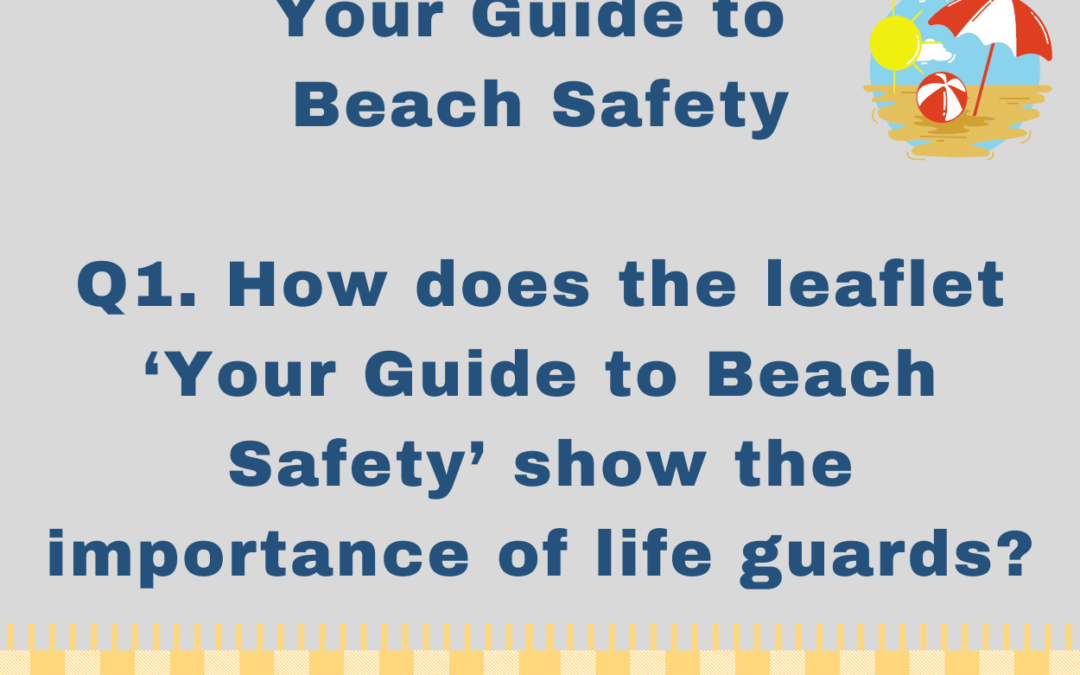Edexcel English IGCSE: Your Guide to Beach Safety by V Denman
Q1. How does the leaflet ‘Your Guide to Beach Safety’ show the importance of life guards?
In your answer, you should write about:
- the layout of the leaflet;
- the use of images;
- the information provided in the leaflet;
- the use of language techniques.
You should refer closely to the leaflet to support your answer. You may use brief quotations.
Edexcel English IGCSE Model Essay by an Expert
This leaflet shows how important the lifeguards are for the safety of visitors to the beach. The potential dangers of the sea are highlighted, and the ways in which lifeguards can help are described throughout the leaflet. On the back page, lifeguards are described as vital lifesavers.
Various features of the leaflet characterise the sea as a dangerous place, which positions lifeguards as essential. The bright red and yellow colours act as warning signals; the colours alert the reader of potential dangers. The “True Story” vividly describes how dangerous the sea can be. The language used in the story is relatively simple, stating outright the terror caused by the experience: “seriously wrong” and “terrifying”, for example. The use of the conditional at the end of the story – “my boys would have drowned” – creates a strong emotional impact, and shows the potentially devastating consequences, had the lifeguards not been present. The emphasis throughout the leaflet on the dangers of the sea show that lifeguards are necessary, because things can very easily go wrong.
Throughout the leaflet, the essential role of lifeguards is described. The slogan displayed on the front and back pages emphasise the lifeguards’ crucial role: “RNLI Lifeboats, Lifeguards, Life First” plays on the word “life”, showing that the role of lifeguards is to preserve life and therefore protect people. Although there is advice about how to stay safe in the sea, the main message of the leaflet is that if someone is in trouble, you should find a lifeguard to help. At the bottom of the pages ‘Know Your Flags’ and ‘Swimming, Surfing & Bodyboarding’, there are darker coloured boxes which stand out, particularly with the triangular warning signs. These boxes advise the reader to contact lifeguards in an emergency, or to make themselves visible so a lifeguard can help. The presentational features of these boxes make them prominent, showing that they are important sources of advice.
On the back page on the leaflet, there is lots of information about how vital lifeguards are. Statistics are used to show the lifeguards’ importance: they have “saved more than 137,000 lives”. The word “life” is repeated many times – for example “save lives”, “lifesavers” and “Life first” – which emphasises the lifeguards’ role as lifesavers. The image supports this impression, showing lifeguards pulling a weak-looking man out of the water. Emotive language is used to play on people’s fear of the sea: “seconds count” show how quickly disaster can strike, and the image of “a child swept out to sea” appeals to people’s sympathy. By presenting the lifeguards as savers of lives, the leaflet shows just how important they are.
Lifeguards in the leaflet are presented as vital lifesavers in a potentially life-threatening context. Although the leaflet tells people how they can help themselves, the overall message is that lifeguards are absolutely necessary on beaches.



